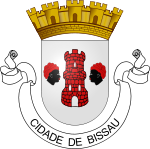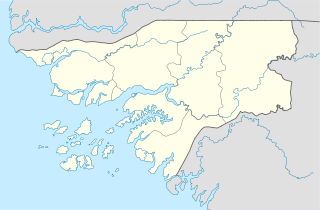
Bissau
Background to the schools Wikipedia
This Wikipedia selection is available offline from SOS Children for distribution in the developing world. Before you decide about sponsoring a child, why not learn about different sponsorship charities first?
| Bissau | |||
|---|---|---|---|
|
|||
|
|
|||
| Coordinates: 11°51′N 15°34′W Coordinates: 11°51′N 15°34′W | |||
| Country | |||
| Region | Bissau Autonomous Sector | ||
| Region | |||
| Area | |||
| • Total | 30 sq mi (77 km2) | ||
| Population (2007) | |||
| • Total | 407,424 est. | ||
| • Density | 13,704/sq mi (5,291.2/km2) | ||
Bissau is the capital city of Guinea-Bissau. The city's borders are conterminous with the Bissau Autonomous Sector. In 2007, the city had an estimated population of 407,424 according to the Instituto Nacional de Estatística e Censos. The city which is located on the Geba River estuary, off the Atlantic Ocean, is the country's largest city, major port, administrative and military centre.
History and landmarks
The city was founded in 1687 by Portugal as a fortified port and trading centre. In 1942 it became the capital of Portuguese Guinea. After the declaration of independence by the anti-colonial guerrillas of PAIGC, in 1973, the capital of the de facto independent territories was declared to be Madina do Boe, but Bissau remained as the capital of the Portuguese-occupied regions, and the de jure capital of the entire Portuguese Guinea. When Portugal recognized the independence of Guinea-Bissau and pulled out in 1974 due to the military coup of April 25 in Lisbon, the two territories merged and Bissau became the capital of the new independent state.
The city is known for its annual carnival. Other attractions include the Portuguese-built Fortaleza de São José da Amura barracks from the 1700s, containing Amílcar Cabral's mausoleum, the Pidjiguiti Memorial to the dockers killed in the Bissau Dockers' Strike on August 3, 1959, the Guinea-Bissau National Arts Institute, Bissau New Stadium and local beaches. Many buildings in the city were ruined during the Guinea-Bissau Civil War (1998 - 1999), including the Guinea-Bissau Presidential Palace and the Bissau French Cultural Centre (now rebuilt), and the city centre is still underdeveloped.
Geography
Bissau is located at 11°52' North, 15°36' West (11.86667, -15.60) , on the Geba River estuary, off the Atlantic Ocean.
Demographics
The last time an official census was held in the country, in 1991, the city/region had a population of 195,389. However, by 2007, the city had an estimated population of 407,424 according to the Instituto Nacional de Estatística e Censos.
Economy
Bissau is the country's largest city, major port, educational, administrative and military centre. Peanuts, hardwoods, copra, palm oil, and rubber are the chief products. The airport that serves Bissau is Osvaldo Vieira International Airport. Poverty and lack of development is widespread.






